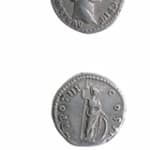Silver Denarius of Marcus Aurelius, 139 CE - 161 CE
Silver
C.4021
Obverse: AVRELIVS CAESAR AVG PII F; Bust of Marcus Aurelius Facing Right. Reverse: TR POT III COS II; Minerva Standing to the Right, Holding a Spear and Leaning on a...
Obverse: AVRELIVS CAESAR AVG PII F; Bust of Marcus Aurelius Facing Right.
Reverse: TR POT III COS II; Minerva Standing to the Right, Holding a Spear and Leaning on a Shield.
This well-preserved coin in VF+ condition was struck for the emperor Marcus Aurelius. Coinage operates as a propagandist device in all cultures, and particularly during the Roman Empire when the borders were uncertain and internal strife threatened to destabilise the economy. The iconography is fairly unambiguous, and shows the powerful emperor associating himself and the Roman state with Minerva, the goddess of warriors, poetry and wisdom, among much else. This might be interpreted as meaning that he was at pains to identify himself with culture as much as martial power. The name Caesar is technically an honorific to show his status, similarly appealing to the populace’s sense of patriotism – to whom Caesar was literally a god – to ensure his power over them.
Born Marcus Annius Catilius Severus in 121 AD, Marcus Aurelius’ family was well-connected to the aristocracy and ruling classes of Rome, including Hadrian, Trajan and Antoninus Pius. He attracted the attention of Hadrian at a young age, and was nicknamed verissimus – truest. Following the death of Hadrian’s adoptive son Lucius Aurelius, Hadrian named Antoninus as his successor on the condition that he adopt Marcus as well as Lucius Aurelius Verus, the son of his own adopted son, and that they succeed him as emperor in their turn. He acceded to power in 161, aged 40, and adopted the name Marcus Aurelius Antoninus.
The empire grew under his authority, with martial success against the Parthians and Germania, and diplomatic relations with states in Central Asia as far east as Han China. His Meditations, written while on campaign, is still used as a reference for leadership and duty and proposed a manner of rational virtue. He was a Stoic philosopher of considerable note, as well as a family man who took his wife and children with him on his trips around the empire. He had fourteen children by Faustina the Younger, of which only one son and four daughters survived him. He was deified upon his death from the Antonine Plague in 180, and was succeeded by Commodus.
This is a striking and attractive ancient coin.
Reverse: TR POT III COS II; Minerva Standing to the Right, Holding a Spear and Leaning on a Shield.
This well-preserved coin in VF+ condition was struck for the emperor Marcus Aurelius. Coinage operates as a propagandist device in all cultures, and particularly during the Roman Empire when the borders were uncertain and internal strife threatened to destabilise the economy. The iconography is fairly unambiguous, and shows the powerful emperor associating himself and the Roman state with Minerva, the goddess of warriors, poetry and wisdom, among much else. This might be interpreted as meaning that he was at pains to identify himself with culture as much as martial power. The name Caesar is technically an honorific to show his status, similarly appealing to the populace’s sense of patriotism – to whom Caesar was literally a god – to ensure his power over them.
Born Marcus Annius Catilius Severus in 121 AD, Marcus Aurelius’ family was well-connected to the aristocracy and ruling classes of Rome, including Hadrian, Trajan and Antoninus Pius. He attracted the attention of Hadrian at a young age, and was nicknamed verissimus – truest. Following the death of Hadrian’s adoptive son Lucius Aurelius, Hadrian named Antoninus as his successor on the condition that he adopt Marcus as well as Lucius Aurelius Verus, the son of his own adopted son, and that they succeed him as emperor in their turn. He acceded to power in 161, aged 40, and adopted the name Marcus Aurelius Antoninus.
The empire grew under his authority, with martial success against the Parthians and Germania, and diplomatic relations with states in Central Asia as far east as Han China. His Meditations, written while on campaign, is still used as a reference for leadership and duty and proposed a manner of rational virtue. He was a Stoic philosopher of considerable note, as well as a family man who took his wife and children with him on his trips around the empire. He had fourteen children by Faustina the Younger, of which only one son and four daughters survived him. He was deified upon his death from the Antonine Plague in 180, and was succeeded by Commodus.
This is a striking and attractive ancient coin.



